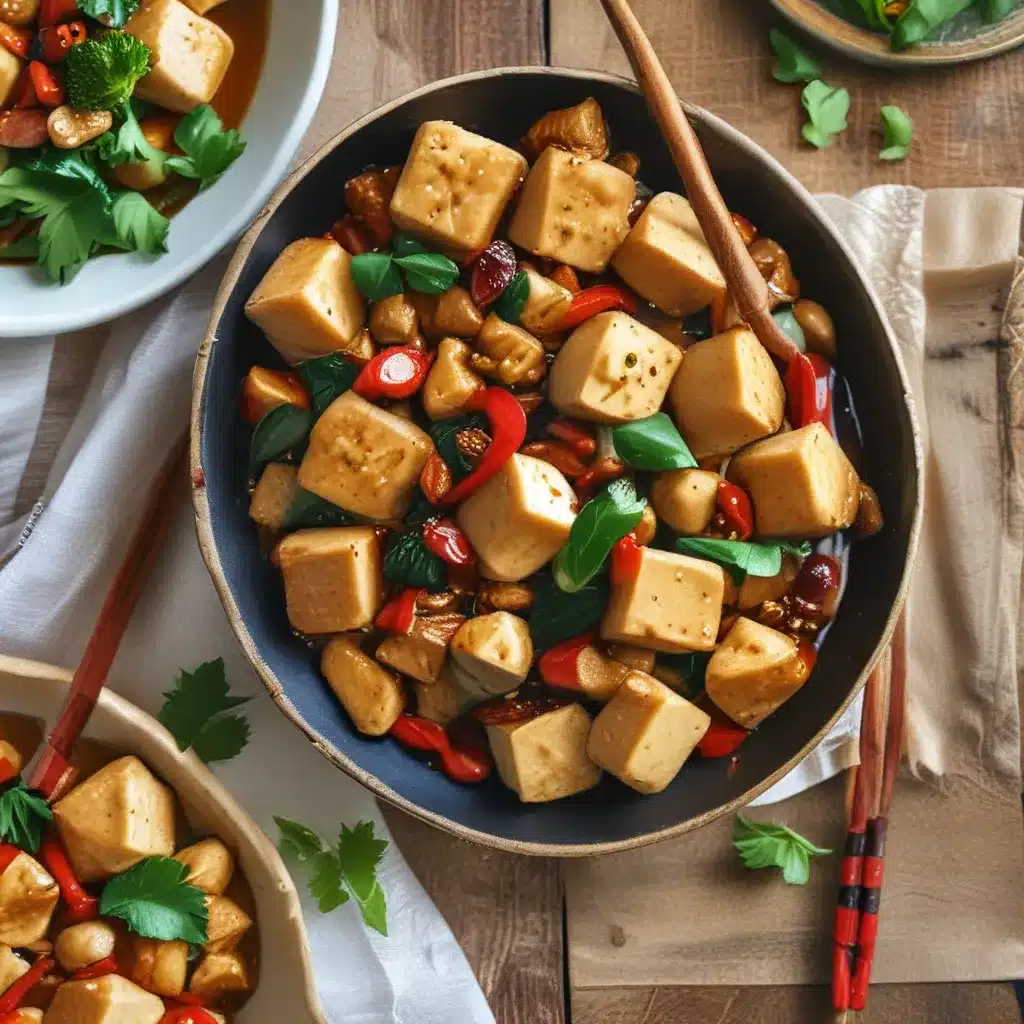
Discovering the Umami Depths of Kung Pao Tofu
I’ll never forget the first time I tasted the legendary kung pao tofu at One Dragon Restaurant in Shanghai. It was a life-changing experience that turned my preconceptions of vegetarian Chinese cuisine on their head.
I had wandered into the unassuming restaurant, drawn in by the tantalizing aromas wafting out onto the bustling street. As I settled into my seat, I scanned the menu, my eyes immediately landing on the kung pao tofu. “A vegetarian twist on a classic?” I thought, my curiosity piqued. Little did I know that I was about to embark on a culinary journey that would forever change the way I approached plant-based dishes.
One Dragon Restaurant is known for its innovative approach to traditional Shanghai cuisine, and their kung pao tofu is a shining example of this philosophy. Rather than relying on the usual suspects of chicken or beef, they’ve masterfully crafted a dish that puts the humble tofu front and center, transforming it into a flavor powerhouse that rivals the original.
Unlocking the Secrets of Silky Kung Pao Tofu
As the dish arrived at my table, I was immediately struck by its captivating appearance. The cubes of tofu, perfectly golden and crisp on the outside, glistened with a glossy, caramelized sauce that had me salivating in anticipation. Nestled among the tofu were vibrant red chili peppers, crunchy peanuts, and a medley of aromatic vegetables, all coming together in a harmonious dance of textures and flavors.
But what truly set this kung pao tofu apart was the depth of umami that permeated every bite. The chefs at One Dragon have clearly spent countless hours perfecting the balance of flavors, drawing on a wealth of culinary techniques and ingredients to create a dish that is both familiar and entirely novel.
As the New Yorker article mentions, the secret to this kung pao tofu’s success lies in the use of “kitchen scraps” – the often-overlooked stems, cores, and leaves that are typically discarded. By incorporating these humble ingredients into the flavorful sauce, the chefs have unlocked a new dimension of umami that elevates the dish to a level of pure, unadulterated deliciousness.
A Textural Masterpiece
As I took my first bite, I was immediately struck by the contrasting textures that danced on my tongue. The crisp, golden exterior of the tofu gave way to a soft, silky interior, creating a sensation that was both satisfying and surprising. The crunchy peanuts and chili peppers provided a delightful counterpoint, while the tender vegetables added a touch of freshness and crunch.
It was as if the chefs had carefully choreographed every element of the dish, ensuring that each component played a crucial role in the overall experience. As the Reddit post on homemade kung pao tofu suggests, the secret to achieving this textural perfection lies in the precise timing and preparation of the ingredients.
Elevating the Humble Tofu
What truly sets this kung pao tofu apart, however, is the way it elevates the humble tofu to a new level of culinary sophistication. Too often, vegetarian dishes are relegated to the sidelines, seen as a poor substitute for their meat-based counterparts. But at One Dragon, the tofu is the star of the show, showcasing its versatility and the incredible depth of flavor it can achieve.
As the New York Times Cooking video demonstrates, the key to transforming tofu into a flavor-packed delight lies in the careful preparation and seasoning. By frying the tofu until it develops a crisp, golden exterior and then coating it in a savory, umami-rich sauce, the chefs have created a dish that is both satisfying and completely meatless.
A Vegetarian Revelation
As I savored each bite of the kung pao tofu, I found myself transported to a new culinary realm, one where the boundaries between vegetarian and traditional Chinese cuisine had been erased. This dish was not a mere imitation or a poor substitute, but rather a masterful reinvention that celebrated the inherent qualities of the tofu and the ingenuity of the chefs.
In that moment, I understood why the New Yorker article had described the vegetarian offerings at restaurants like One Dragon as “both innovative and traditional.” By embracing the rich history and flavors of Chinese cuisine while simultaneously pushing the boundaries of what’s possible with plant-based ingredients, these chefs have created a dining experience that is truly transformative.
A Culinary Journey of Exploration
As I savored the last bite of the kung pao tofu, I found myself reflecting on the journey I had just embarked upon. What had started as a simple curiosity had blossomed into a profound appreciation for the culinary artistry of One Dragon Restaurant and the power of tofu to transcend its humble origins.
I knew that I would return to this restaurant time and time again, eager to explore the other vegetarian marvels they had in store. For me, this kung pao tofu had become more than just a dish – it was a gateway to a new world of culinary possibilities, one where the boundaries between meat and plant-based ingredients had been irrevocably shattered.
In the end, my encounter with the silky, umami-laden kung pao tofu had not only changed the way I approached vegetarian Chinese cuisine, but had also inspired me to approach all my meals with a renewed sense of curiosity and open-mindedness. After all, as the chefs at One Dragon have so eloquently demonstrated, the true essence of great cooking lies not in the ingredients themselves, but in the boundless creativity and passion of those who craft them into culinary masterpieces.






